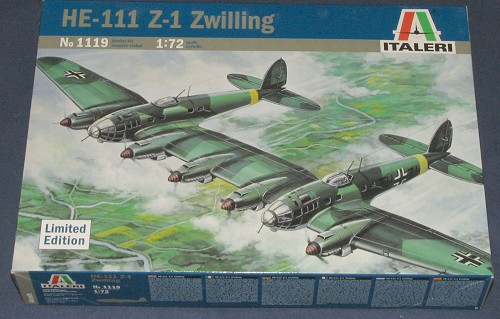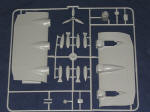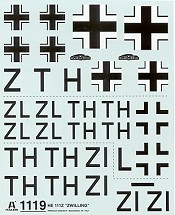
| KIT: | Italeri 1/72 He-111Z 'Zwilling' |
| KIT #: | 1119 |
| PRICE: | $59.00 MSRP |
| DECALS: | Two options |
| REVIEWER: | Scott Van Aken |
| NOTES: | Limited Edition - reissue |

| HISTORY |
The He-111Z was an unorthodox and ingenious utilization of the standard He-111H-6 bomber in order to provide a tug capable of pulling the huge Me-321 glider. Previously, three Bf-110s were used but this proved to be dangerous at best so the five engined 'Zwilling' (Twin) was produced by mating two standard He-111s to a common center wing section that included an additional engine. The pilot was in the port fuselage and the crew was 7-9 men, depending on how many defensive positions required manning. Even this was not always enough power to haul a fully loaded Me-321 so often rocket assist units were used to help get the glider airborne. The Z could also haul two or three Go-242 gliders. The He-111Z was almost exclusively used on the Russian front where the need to haul a lot of material great distances was paramount. It was also planned to do a long range bomber and long range recce version of the Z, but those did not reach fruition thanks to the deteriorating war situation.
| THE KIT |
 Italeri's
He-111H-6 has been around for decades. Until the release of the new
Hasegawa kits, it was arguably the best He-111 kit available in 1/72. It
was obvious to the Italeri folks that they had the makings for the Z, so
the required additional sprue was included that had the wing center section
with its additional engine as well as a set of fuel tanks. When you open
the box, you see one complete He-111H in a bag. The other has a complete
kit minus the sprue that has the wings on it, so it was pretty obvious that
they'd decided to do a Z from the outset. I've shown only the new sprue.
You can see the rest of the kit by visiting
this preview.
Italeri's
He-111H-6 has been around for decades. Until the release of the new
Hasegawa kits, it was arguably the best He-111 kit available in 1/72. It
was obvious to the Italeri folks that they had the makings for the Z, so
the required additional sprue was included that had the wing center section
with its additional engine as well as a set of fuel tanks. When you open
the box, you see one complete He-111H in a bag. The other has a complete
kit minus the sprue that has the wings on it, so it was pretty obvious that
they'd decided to do a Z from the outset. I've shown only the new sprue.
You can see the rest of the kit by visiting
this preview.
The years have been kind to the He-111 sprues. Mine were well formed with no flash. There are ejector pin marks in a few areas you'd rather they not be, but that is the case with older molds. The only sink areas I found were on some of the crew members, and you get quite a few of these folks with your kit. Clear bits are well done with nice crisp frame work, making a rather extensive masking job more manageable.
 As you'd expect, there will
be quite a few bits left over, specifically the torpedoes, bombs and
various bomb racks. Those are not needed on what is basically a tug. You'll
also have some spare landing gear bits as well.
As you'd expect, there will
be quite a few bits left over, specifically the torpedoes, bombs and
various bomb racks. Those are not needed on what is basically a tug. You'll
also have some spare landing gear bits as well.
The instructions are quite extensive as this is not a small build. There are directions to sand off the raised detail on the instrument panels so you can replace this with a decal. Markings are given for two aircraft, both in Russia during 1943. Both have RLM 65 undersides with yellow lower wing tips and fuselage bands. The big difference is that one has a white winter upper surface while the other is in the usual RLM 70/71 splinter camo. I have to tell you that for some odd reason, Italeri uses some wrong shades for their overall paint colors telling you to use Light Ghost Grey for the undersides and to use RAL 6003 and FS 34092 for the upper colors. This is quite puzzling as Testors does a full line of RLM shades in their enamel line. The decal sheet is basically black and white with crosses and codes. No swastikas so you'll have to dig up four of them from an aftermarket sheet for this one.
| CONCLUSIONS |
It is nice to see old favorites reissued from time to time. It allows those who haven't had a chance, to obtain and build some of the more interesting types.
September 2005
| REFERENCES |
Instruction sheet
Thanks to
 for the review kit. You can find Italeri kits at your favorite hobby shop
or on-line at
www.testors.com
for the review kit. You can find Italeri kits at your favorite hobby shop
or on-line at
www.testors.com
If you would like your product reviewed fairly and quickly by a site that has around 300,000 visitors a month, please contact me or see other details in the Note to Contributors.